IJCRR - 3(6), June, 2011
Pages: 10-25
Print Article
Download XML Download PDF
IMPROVED GROUP ACCEPTANCE SAMPLING PLAN FOR MARSHAL-OLKIN EXTENDED LOMAX DISTRIBUTION PERCENTILES
Author: Muhammad Aslam, Muhammad Shoiab, Y.L. Lio, Chi-Hyuck Jun
Category: General Sciences
Abstract:In this paper, a group acceptance sampling plan, based on the number of failures occurred from all groups, is proposed for Marshal-Olkin extended Lomax distribution percentiles under the truncated life test. The minimum number of groups needed for a given group size and acceptance number are determined by using the two-point approach, that meets the consumer's and producer's risks at the specified percentile quality levels, respectively. The advantages of the designed plan are discussed by comparing with original group acceptance plan proposed by Aslam and Jun (2009). The tables are constructed and results are explained with examples.
Keywords: Group acceptance sampling plan; Marshal- Olkin extended Lomax distribution, consumer‘s risk, producer‘s risk, Truncated life test.
Full Text:
1. INTRODUCTION
Acceptance sampling scheme is concerned with inspecting the product and making the decision by using the sample information. Accepting sampling is one of the major techniques in SQC to assure the quality of the product. It is widely used in the field of industry and business to manage the product reliability and to make the decision of accepting or rejecting the product by the consumer. Today, products are designed to be with high reliability, and most of them suffer destructive life tests to collect life information. In contrast with 100% inspection, acceptance sampling plans have the advantage to reduce the cost and meanwhile to ensure that the product quality meets the standard of the consumer. The essential technique of acceptance sampling is to establish the minimum number of sample items for the test. Due to the fact that it could be difficult to observe the complete lifetime of a high reliability item, the truncated life test would be combined with a sampling plan to save time, cost, efforts, manpower, electricity of experiment. Time truncated life test for a various distributions were discussed by Epstein (1954), Goode and Kao (1961), Kantam and Rosaiah (1998),Kantam et al. (2001), Balkizi (2003), Rosaiah et al. (2006), Rosaiah and Kantam (2005), Tsai and Wu (2006), Rosaiah et al. (2007), Aslam and Kantam (2008), Balakrishnan et al. (2007), Aslam and Jun (2010) and Radhakrishnan and Vinotha (2011).
In many situations, putting a number of items in a tester for life test could save time and cost more. In this life test, the tester is called the group and the number of items in each tester is called the group size. An acceptance sampling plan with these groups of items is called the group acceptance sampling plan. The testers had been used in the sudden death testing by Pascual and Meeker (1998) discussed how sudden death experiment could significantly reduce testing time and still yield the estimates of the Weibull percentiles that were as precise as when all sample lifetimes used. Jun et al. (2006) also studied variable sampling plans for Weibull distribution under the sudden death testing. More recently, Aslam and Jun (2009) proposed the group acceptance sampling plan for life test under the inverse Rayleigh or log-logistic distribution. Rao (2010) developed the Marshal-Olkin extended Lomax distribution for a group acceptance sampling plan based on truncated life test. In these papers, using the single point approach to satisfy the consumer‘s risk, the producer‘s risk was not considered. Traditionally, acceptance plans are designed based on the mean lifetime of items for assuring the quality level of the product. However, the sampling plans based on the population mean may not catch the specific percentile of lifetimes asked from the designed considerations of engineering. According to Lio et al. (2010) when the quality of interest is a low percentile, the sampling plans based on the population mean could pass the lot but the required low percentile is below the prespecified standard asked from the customer. Furthermore, a small decrease in the mean with a simultaneous small increase in variance can result in a significant downward shift in small percentiles of interest. This means that a lot of products could be accepted due to a small decrease in the mean lifetime after inspection. But the low percentile of lifetime for products in the accepted lot may not meet the consumer‘s expectation. Lio et al. (2010a, 2010b) introduced acceptance sampling plans based on truncated life test for Birnbaum- Saunders percentiles and Burr Type XII percentiles, respectively Two risks in acceptance sampling plan play a vital role for assuring the quality of the product. Consumer‘s and producer‘s risks are fairly well defined in terms of good product rejected and bad product accepted. In this paper, the two-point approach, which had been used for designing variable acceptance sampling plans by Fertig and Mann (1998) and by Jun et al. (2006), is used to design the proposed group acceptance sampling plan toprotect the consumer‘s and produce‘s risks. The main purpose of this paper is to develop the group acceptance sampling plan under the truncated life test for the percentile of product lifetimes which follow the Marshal-Olkin extended Lomax distribution by using the two-point approach.
2. Introduction of distribution
Assume that the product lifetimes follow the Marshall-Olkin extended Lomax distribution, whose probability density function (pdf) and cumulative distribution function (cdf) are, respectively, given by:
Ghitany et. al. (2007) investigated properties of the Marshal-Olkin extended Lomax distribution and fitted the distribution to a randomly censored lifetimes. Since then, the Marshal-Olkin extended Lomax distribution has been applied to model the product lifetime and the acceptance sampling plans; for examples, Srinivasa Rao et al. (2008) and Srinivasa Rao et. al. (2009) studied single acceptance sampling plan for the mean of the Marshal-Olkin extended Lomax distribution.
3. Group Sampling Plan Based on Total Number of Failures
The consumer‘s risk, , is used as the significance level for this hypothesis testing and 1 is called the consumer‘s confidence level. The proposed group acceptance sampling plan under the total number of failures is stated below:
1. Draw the random sample of size n from a lot, allocate r items to each of g groups (or testers) so that n rg and put them on test until the pre-determined time 0 t .
2. When the test is terminated at the predetermined time 0 t , the lot is accepted if the number of failures from g groups is smaller than or equal to c ; otherwise, the lot is rejected.
3. The lot is rejected and the life test is truncated before 0 t as soon as the total number of failures from g groups is larger than c before 0 t . Since the lot of products is accepted only if the number of failures from all groups is smaller than or equal to the specified acceptance number c, the lot acceptance probability can be calculated as,
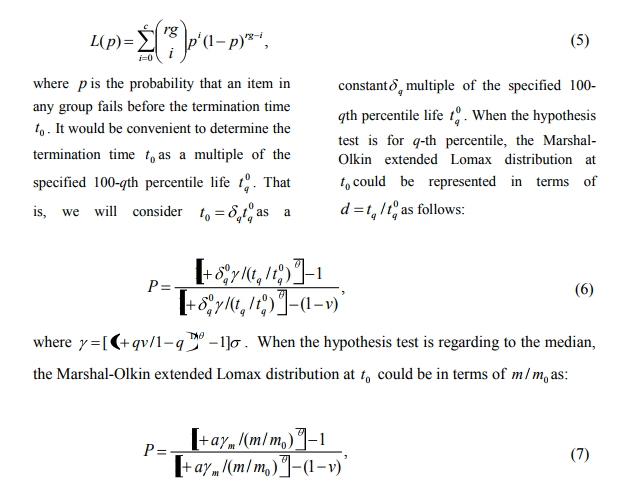
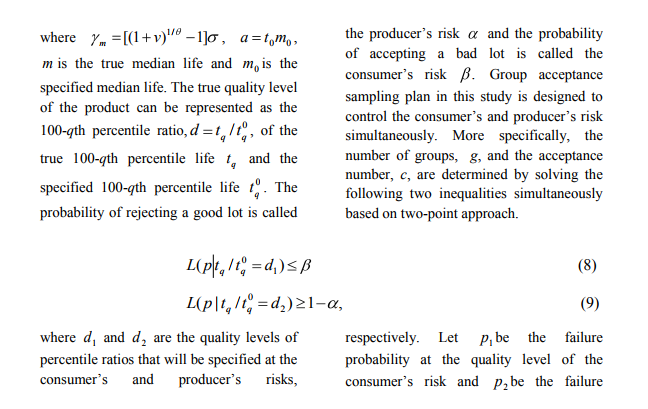
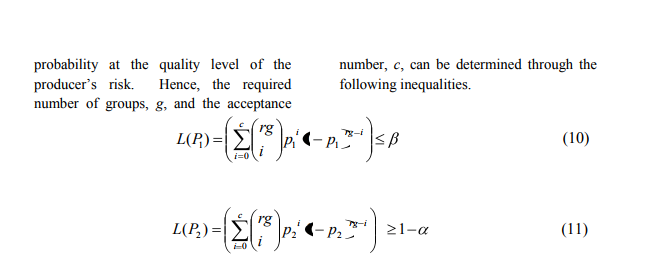
It can be seen that the solutions for g and c are independent of the scale parameter . It should be noticed that the failure probability, 1 p , at the quality level of the consumer‘s risk is called the lot tolerance reliability level (LTRL) and the failure probability, 2 p , at the quality level of the producer‘s risk is called the acceptable reliability level (ARL).
4. Description of Tables and Examples
Given group size, r 5, or 10 , and the termination time multiplier q 0.5 or 1.0 , the minium number of groups g and the acceptance numbers c required for the proposed group acceptance sampling plans to ensure the 100-qth percentile life, where q 0.1, 0.5 , have been obtained under various consumer‘s risk values ( 0.25,0.10,0.05,0.01) at the true 100-qth percentile equal to the specified life and the producer‘s risk value 0.05 at the true 100-qth percentile ratios 2 d = (4,6,8,10,12). The results for population parameters (v 3, 3), (v 2, 3) and (v 3, 4) are given in Tables 1-6. Tables 1-3 provide the group acceptance sampling plans for 10 percentile life and Tables 4-6 show the group acceptance sampling plans for median life. Let the product lifetimes have the MarshalOlkin extended Lomax distribution with parameters 3 and 3 . To protect the consumer‘s risk of 0.25 at the prespecified 10 percentile life 0 q t and the producer‘s risk of 0.05 at the true 10 percentile life equal to 4 times of 0 q t , Table 1 shows that the group sampling plan should use 21 testers with 5 items in each tester and the acceptance number c 3 , if the life test would be terminated at 0 0.5 q t . To protect the consumer‘s risk of 0.25 at the pre-specified median life 0 q t and the producer‘s risk of 0.05 at the true median life equal to 4 times of 0 q t , Table 4 shows that the group sampling plan must use 5 testers with 5 items in each tester and the acceptance number c 4 , if the life test would be terminated at 0 0.5 q t . Similarly, given the same protections for consumer and producer as mentioned above, assuming the product lifetimes have the Marshal-Olkin extended Lomax distribution with parameters 2 and 3 , Table 2 indicates that the group sampling plan needs 20 testers with 5 items in each tester and the acceptance number c 3 , if the life test would be terminated at 0.5 multipliers of specified 10 percentile life 0 q t . In viewing Tables 1-6, it could be noticed that when the ratio 0 / q q t t increases, the number of groups and the acceptance numbers decrease at the same time.
Example 1.
Suppose that the lifetimes of products follow the Marshal-Olkin extended Lomax distribution with shape parameters v 2, 3 . It is desired to design a group acceptance sampling plan to test that the median life is greater than 2000 hours and manufacturer wants to run an experiment for 1000 hours using testers equipped with 5 products each. Let us assume that the consumer‘s risk is 0.25 and the producer‘s risk is 5% when the true percentile is 12,000 hours. Since v 2, 3, 0.25,r 5, q 0.5,and / 6 0 q q t t for this example, the minimum number of groups and acceptance can be found as g 3,c 2 from Table 5. This indicates that 15 products are needed for life testing and that 5 products are allocated to each of 3 testers. We will accept the lot if no more than 2 failures observed before 1000 hours in 3 groups. Example 2. In this example, the data set of successive failure intervals for the air conditioning system of jet plane 8044 reported by Proschan [21] is used. The data set contains 12 observations, 487, 18, 100, 7, 98, 5, 85, 91, 43, 230, 3, 130 (in hours). Fitting this data with the Marshal-Olkin extended Lomax distribution, Ramesh C. Gupta (2009) provided the shape parameter 3.5750 and the index parameter 1.4476 . The number of groups and acceptance numbers for this case of Marshal-Olikin extended Lomax distribution are given in Table 7 for 0.25, 0.05 and 10-th percentile.
5. Comparison
Figure 1 and Figure 2 present the comparison in terms of the number of groups needed between the proposed plan and the original group acceptance sampling plans proposed by Aslam and Jun (2009). Both figures indicate that the proposed sampling plan is better than the original sampling plan proposed by Aslam and Jun (2009), since the number of groups needed for the proposed sampling plan is smaller than the number of groups needed for the sampling plan proposed by Aslam and Jun (2009), given a percentile ratio 0 / q q t t . Figure 3 and Figure 4 present the comparison again in terms of the number of groups needed between Marshal-Olkin extended Lomax distribution and generalized log-logistic distribution. It can be noticed that Figure 3 and Figure 4 show the proposed distribution is better than the generalized log-logistic distribution because the number of groups needed for the case of Marshal-Olkin extended Lomax distribution is smaller than the number of groups needed for the case of generalized log-logistic distribution, given a percentile ratio 0 / q q t t .
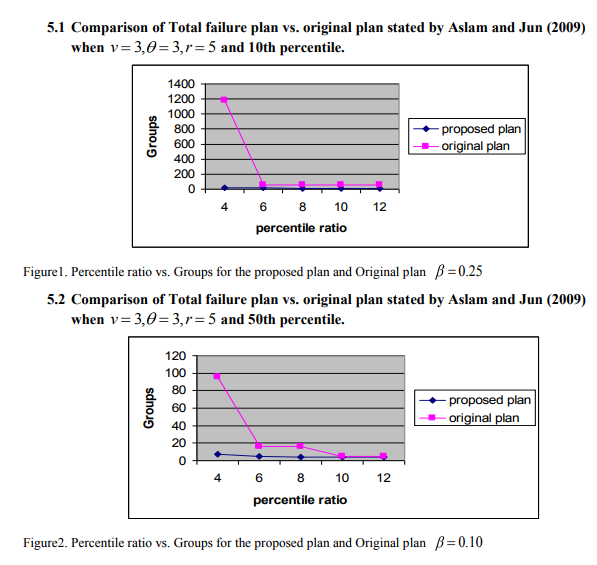
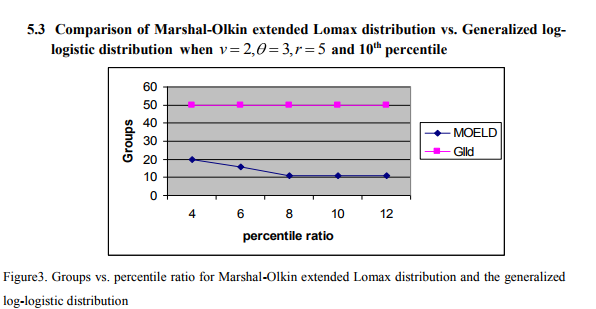
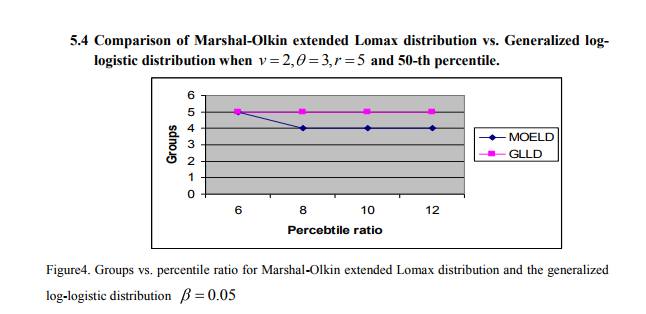
5. CONCLUSION
In this paper, we proposed the Group acceptance sampling plan based on the number of failures from all groups for Marshal-Olkin extended Lomax distribution percentile lifetime. The two point approach was adopted to determine the required minimum number of groups and acceptance numbers. This paper only deals with the Marshal-Olkin extended Lomax distribution to check the multiple numbers of items simultaneously by saving cost and time. This paper indicate that the proposed plan is better than the original plan (stated by Aslam and Jun (2009)) because the number of groups is smaller as compared to the original plan proposed by Aslam and Jun (2009). This paper also indicates that the Marshal-Olkin extended Lomax distribution is better than the generalized log-logistic distribution because the number of groups is smaller for the case of Marshal-Olkin extended Lomax distribution. The present plan can be used to inspect the many electronic things including for example air conditioning system of jet plane.
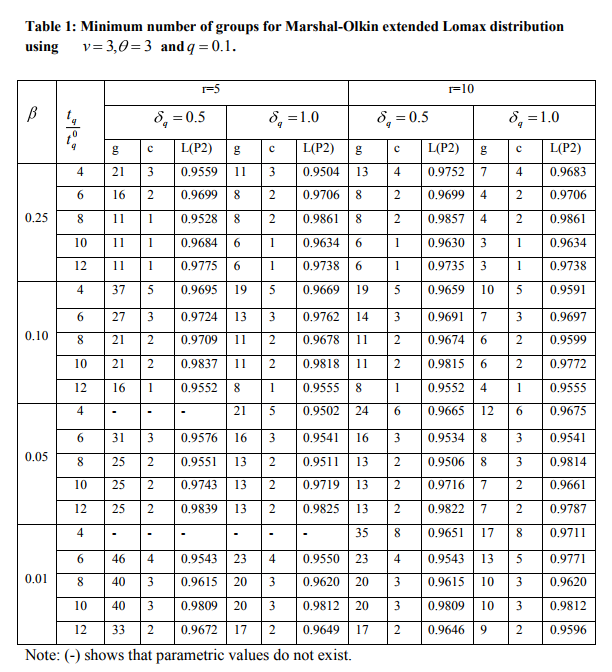
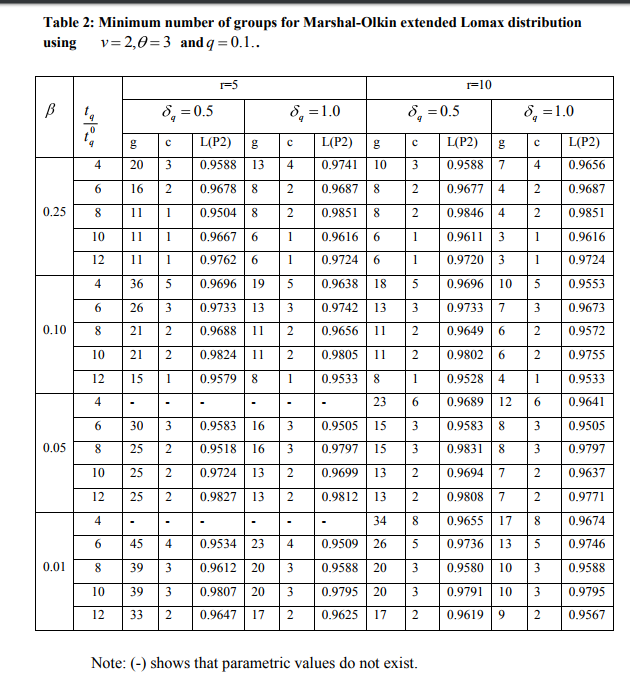

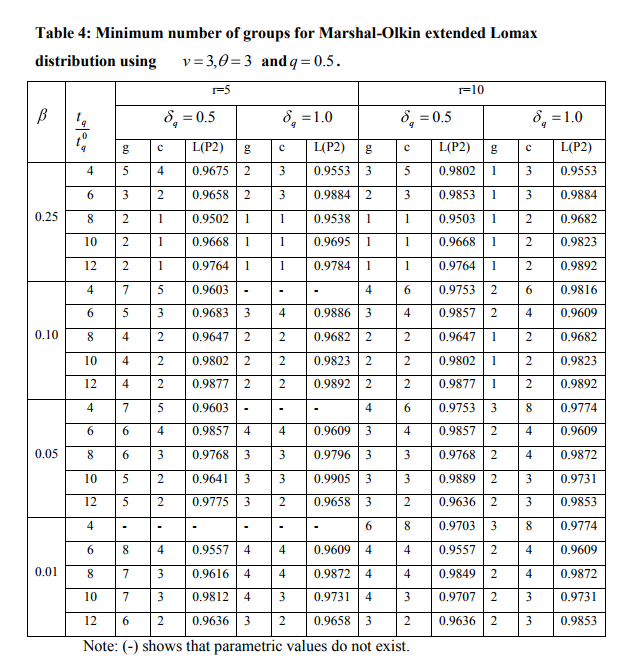
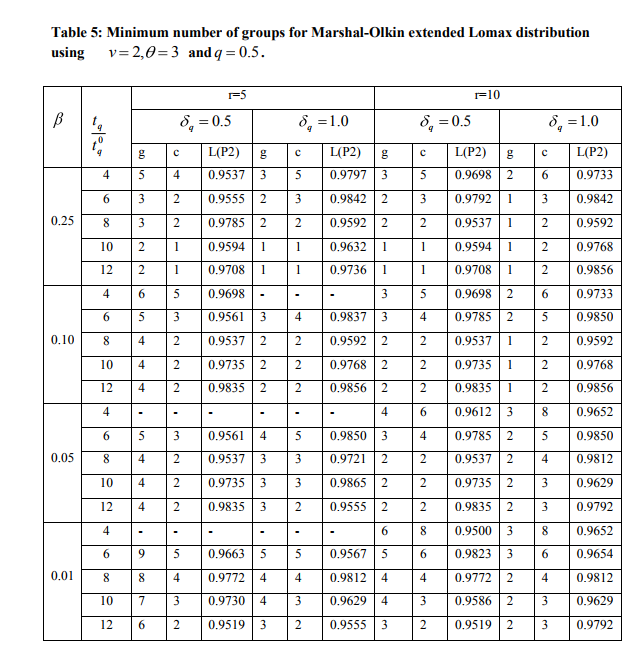
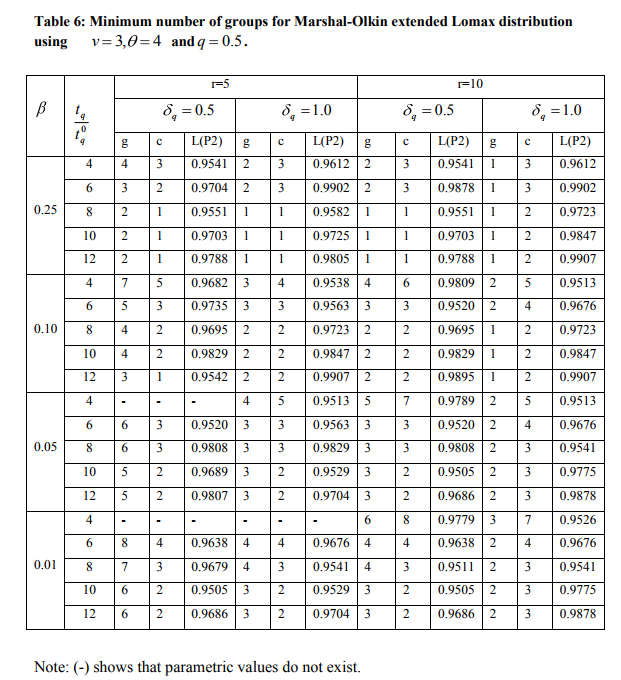
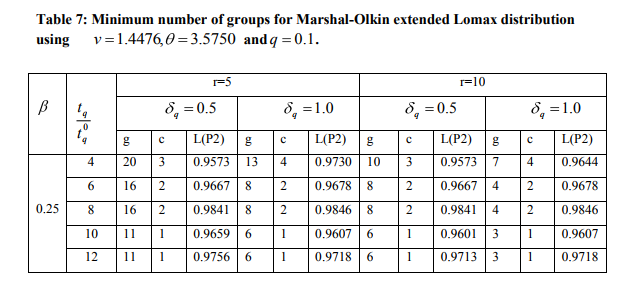
References:
1. Aslam, M., and Jun, C.-H. (2009). A group acceptance sampling plans for truncated life tests based on the inverse Rayleigh and log-logistic distribution. Pakistan Journal of Statistics, 25, 1-13.
2. Aslam, M., and Jun, C.-H. (2010). A double acceptance sampling plan for generalized log-logistic distributions with known shape parameters. J. App. Statist., 37(3), 405-414.
3. Aslam, M., and Kantam, R.R.L. (2008). Economic reliability acceptance sampling based on truncated life tests in the BirnbaumSaunders distribution. Pakistan Journal of Statistics, 24, 269-276.
4. Baklizi, A. (2003). Acceptance sampling based on truncated life tests in the Pareto distribution of the second kind. Advances Appl. Statist., 3(1), 33- 48.
5. Balakrishnan, N., Leiva, V. and Lopez, J. (2007). Acceptance sampling plans from truncated life tests based on the generalized Birnbaum-Saunders distribution. Comm. Statist. - Simu. And Compu., 36, 643-656.
6. Epstein, B. (1954). Truncated life tests in the exponential case. Ann. Math. Statist. 25,555-564.
7. Fertig, F.W., and Mann, N.-R (1980). Life test sampling plans for two parameter Weibull distributions. Technometrics, 22(2), 160-167.
8. Ghitany, M. E., Al-Awadhi, F. A., Alkhalfan, L. A. (2007). Marshal-Olkin extended Lomax distribution and its application to censored data. Communication in Statistics Theory and Methods, 36, 1855-1866.
9. Goode, H.P. and Kao, J.H.K. (1961). Sampling plans based on the Weibull distribution. In Proceeding of the Seventh National Symposium on Reliability and Quality Control, (24- 40). Philadelphia.
10. Jun, C.-H., Balamurali, S. and Lee, S.- H. (2006). Variables sampling plans for Weibull distribution lifetimes under sudden death testing. IEEE Transactions on Reliability 55, 53-58.
11. Kantam, R.R.L. and Rosaiah, K. (1998). Half logistic distribution in acceptance sampling based on life tests, IAPQR Transactions, 23(2), 117- 125.
12. Kantam, R.R.L., Rosaiah, K. and Rao, G.S. (2001). Acceptance sampling based on life tests: Log-logistic models. J. App. Statist., 28(1), 121- 128.
13. Lio, Y.L., Tsai, Tzong-Ru and Wu, Shuo-Jye. (2010a). Acceptance sampling plans from truncated life tests based on the Birnbaum-saunders distribution for Percentiles. . Comm. Statist. - Simu. And Compu., 39(1), 119-136
14. Lio, Y.L., Tsai, Tzong-Ru and Wu, Shuo-Jye. (2010b). Acceptance sampling plans from truncated life tests based on Burr type XII percentiles. Journal of Chinese institute of Industrial Engineers., 27(4), 270-280.
15. Pascual, F.G. and Meeker, W.Q. (1998). The modified sudden death test: planning life tests with a limited number of test positions. Journal of Testing and Evaluation 26, 434-443.
16. Radhakrishnan., R. and Vinotha, P. (2011). Construction of repetitive group sampling plan indexed through producer‘s nano quality level and consumer‘s nano quality level, International Journal of Current Research and Review, 2 (2), 62-66
17. Rosaiah, K. and Kantam, R.R.L. (2005). Acceptance sampling based on the inverse Rayleigh distribution. Eco. Quality Control, 20(2), 277-286.
18. Rosaiah, K., Kantam, R.R.L. and Santosh Kumar, Ch. (2006). Reliability of test plans for exponentiated loglogistic distribution, Eco.Quality Control, 21(2), 165-175.
19. Rosaiah, K., Kantam, R.R.L. and Santosh Kumar, Ch. (2007). Exponentiated log-logistic distributionAn economic reliability test plan. Pak. J. Statist., 23(2), 147-146.
20. Srinivasa Rao, G., Ghitany, M.E., Kantam, R.R.L. (2008). Acceptance sampling plans for Marshal-Olkin extended Lomax distribution. International Journal of Applied Mathematics,
21 (2), 315-325. 21. Srinivasa Rao, G., Ghitany, M.E., Kantam, R.R.L. (2009). Acceptance sampling plans for Marshal-Olkin extended Lomax distribution. International Journal of Applied Mathematics, 22 (1), 139-148.
22. Tsai, Tzong-Ru and Wu, Shuo-Jye (2006). Acceptance sampling based on truncated life tests for generalized Rayleigh distribution. J. App. Statist., 33(6), 595-600.
|






 This work is licensed under a Creative Commons Attribution-NonCommercial 4.0 International License
This work is licensed under a Creative Commons Attribution-NonCommercial 4.0 International License